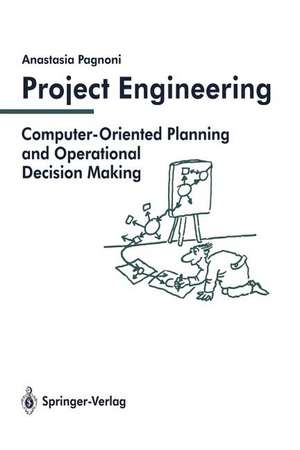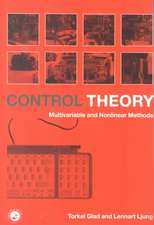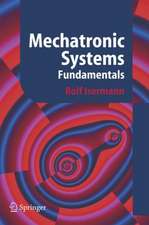Project Engineering: Computer-Oriented Planning and Operational Decision Making
Autor Anastasia Pagnonien Limba Engleză Paperback – 28 ian 2012
Preț: 330.56 lei
Preț vechi: 413.21 lei
-20% Nou
Puncte Express: 496
Preț estimativ în valută:
63.26€ • 65.26$ • 53.54£
63.26€ • 65.26$ • 53.54£
Carte tipărită la comandă
Livrare economică 05-19 martie
Preluare comenzi: 021 569.72.76
Specificații
ISBN-13: 9783642756320
ISBN-10: 3642756328
Pagini: 260
Ilustrații: XV, 239 p.
Dimensiuni: 155 x 235 x 14 mm
Greutate: 0.37 kg
Ediția:Softcover reprint of the original 1st ed. 1990
Editura: Springer Berlin, Heidelberg
Colecția Springer
Locul publicării:Berlin, Heidelberg, Germany
ISBN-10: 3642756328
Pagini: 260
Ilustrații: XV, 239 p.
Dimensiuni: 155 x 235 x 14 mm
Greutate: 0.37 kg
Ediția:Softcover reprint of the original 1st ed. 1990
Editura: Springer Berlin, Heidelberg
Colecția Springer
Locul publicării:Berlin, Heidelberg, Germany
Public țintă
Lower undergraduateCuprins
1. Survey of Methodologies.- 2. Planning with Temporal Constraints.- 2.1 Graphs, Weighted Graphs, Bipartite Graphs.- Subgraphs.- Digraphs.- Walks in Graphs and Digraphs.- Connected Graphs, Weakly and Strongly Connected Digraphs.- Trees.- Graph Matrices.- Digraph Representation of Plans.- 2.2 Activity Networks.- Planning with Activity Networks.- Activity Network Unfoldings.- 3. Disciplined Planning.- 3.1 Top-Down Development of Plans.- 3.2 Disciplined Planning Syntax.- 4. Planning under Precedence/Duration Constraints: Networking Techniques.- 4.1 No Choices, No Cycles, Known Durations: CPM.- Execution Control: Event Time Bounds.- Critical Paths.- Event Realization Slacks.- Activity Time Bounds.- 4.2 No Choices, No Cycles, Known Direct Costs: Cost-CPM.- Updating of Time Schedule and Cost Plan.- Cost Optimization.- Analytical Cost Optimization Algorithm.- A Heuristic Speeding Up Algorithm.- Operational Considerations.- 4.3 No Choices, No Cycles, Beta-Distributed Durations: PERT.- Probability Distribution of Activity Durations.- The Beta Distribution.- The Critical Path Question.- Investigation of Project Completion Time.- Warnings about Improper Use of PERT.- PERT Cost Planning and Optimization.- Operational Considerations.- 4.4 Choices, Cycles, Random Durations: GERT.- Event Realization “Logics”.- Network Structure.- Probability Distribution of Activity Durations.- STEOR Networks and Markov Renewal Processes.- The MRP Method.- Simulation of GERT Networks.- 5. Clock-Independent Planning: Petri Nets.- 5.1 Causal Interconnection of State and Transition Elements: Nets.- Enabling, Steps, Reachability.- Pure Nets, Simple Nets.- S-Graph, T-Graph, Free Choice Net.- Subnets, S-Vectors, T-Vectors.- 5.2 Causal Interconnection of Conditions and Events: CE Nets.- About Petri NetPlans.- 5.3 Causal Interconnection of Resources and Operations: FT Nets.- Incidence Matrix.- Reachability Graph.- Liveness, Stop States and Home States.- 5.4 Conservation of Resource Counts and Reproduction of States: S- and T-Invariants.- Calculation of Invariants.- Project Analysis by Means of Invariants.- 5.5 Representing Operations with Variable Resources Compactly: an Outline of PrT Nets.- 6. Net Plan Executions.- 6.1 Representing Net Plan Executions.- Execution Nets.- 6.2 Figuring Out Execution Alternatives: Control Nets.- 7. Choosing a Course of Action: Operational Decision Making.- 7.1 Execution Alternatives.- 7.2 The Formal Representation of Vagueness: Fuzzy Sets.- 7.3 Fuzzy Attributes.- Attributes over Operations.- Attributes over Alternatives.- Attributes over Executions.- 7.4 Preference Degree of Executions. Optimal Executions.- Weighted Attributes.- 7.5 Clustering Executions into Preference Classes: Fuzzy Outranking.- Fuzzy Outranking Relation.- Classification of Executions.- Singling out Best Executions: Dichotomy.- Partitioning Executions into Preference Classes: Polychotomy.- References.- Further Reading.













